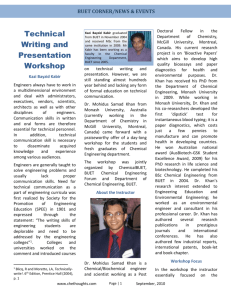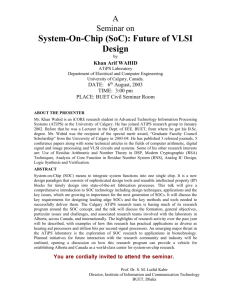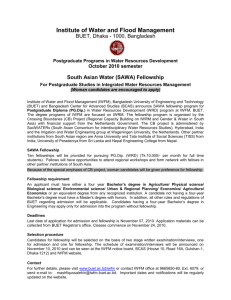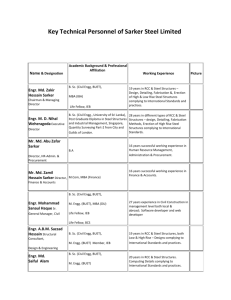Production Optimization and Forecasting
advertisement
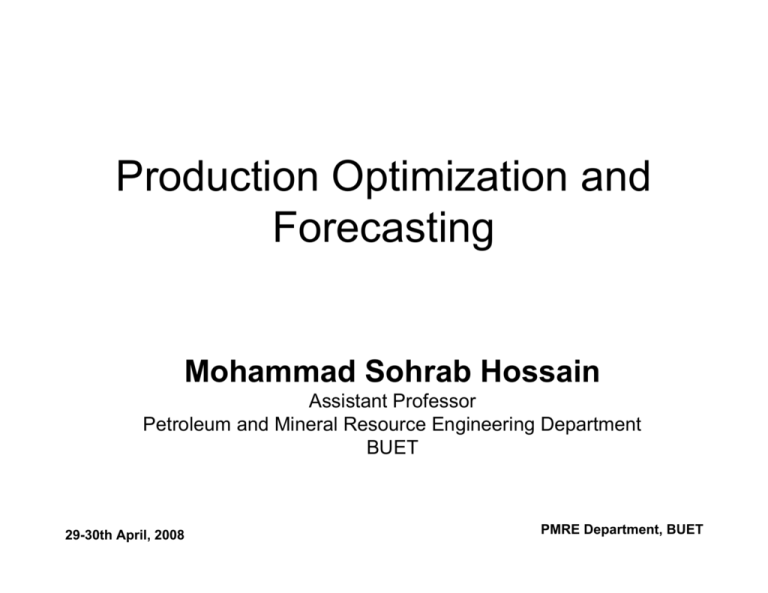
Production Optimization and Forecasting Mohammad Sohrab Hossain Assistant Professor Petroleum and Mineral Resource Engineering Department BUET 29-30th April, 2008 PMRE Department, BUET Production Optimization and Forecasting… • Production optimization means – Balance between production rate / deliverability and demand • Production optimization includes a good understanding about Production Systems & Reservoir fluid 29-30th April, 2008 PMRE Department, BUET Production Systems • Production Systems includes ¾Reservoir (Inflow Performance Relationship) ¾Wellbore (Completions, Tubing etc) ¾Surface Facilities (Flow lines, Separator, Pipelines, etc ) • Production systems can be very simple to complex ¾ Simple – Reservoir, completion, tubing, surface facilities ¾ Complex- Artificial lift system, Water injection and Multiple wells 29-30th April, 2008 PMRE Department, BUET Reservoir Fluid • Properties of the reservoir fluid, like ¾ FVF (Formation Volume Factor), Bo, Bg ¾ Produced Gas/Oil Ratio (GOR) Rp, ¾ Solution Gas Oil Ratio, Rs ¾ Compressibilities Co, Cg ¾ Bubble Point ¾ Gas and Oil Gravities ¾ Densities & Viscosities 29-30th April, 2008 PMRE Department, BUET 29-30th April, 2008 PMRE Department, BUET Production Systems… • Movement or Transport of reservoir fluid from reservoir to surface requires energy to overcome the frictional losses or the pressure drop • The pressure drop of the fluid at any time would be the initial fluid pressure minus the final fluid pressure ∆P = Pi − Psep − ∆P = P r − Psep 29-30th April, 2008 PMRE Department, BUET Production Systems… • Design of a production systems never be separated into reservoir and piping systems The amount of Oil and Gas flowing into the well from reservoir depends on pressure drop in the piping system Piping system pressure drop depends on amount of the fluid flowing through it • Therefore, entire production systems must be analyzed as a unit 29-30th April, 2008 PMRE Department, BUET A Hypothetical Case • A new offshore gas condensate field has been discovered in the Bay of Bengal • Seismic studies and Well tests suggest a very large anticline structure, with possible reserves of 7.8 TCF of gas and 400 million barrels of condensate liquids • The offshore field is 150 miles off from the shore line 29-30th April, 2008 PMRE Department, BUET Considerations • • • • • Reservoir deliverability Lifting of Hydrocarbon Transport to Market Place Flow assurance & Operability Future oil and gas price, Time value of Money etc 29-30th April, 2008 PMRE Department, BUET Deliverability • Provides information on the production rate & Total production as a function of Time ¾ Simplified Approach o Inflow Performance Relationship o Decline Curve Analysis ¾ Analytical Solutions ¾ Reservoir Simulations 29-30th April, 2008 PMRE Department, BUET Lifting Hydrocarbon • Flow in Wellbore ¾Natural Flow ¾Artificial Flow (Water flooding, CO2 flooding) • Flow in Tubing ¾ Natural Flow ¾ Artificial Lift (Gas lift, Beam Pump, ESP) • Flow Characteristics ¾ Single phase ¾ Multiple phase 29-30th April, 2008 PMRE Department, BUET Transport • Ways and Means of transportations ¾ Pipeline ¾Tankers ¾ Others • Flows in pipes and piping components • Flow Control and Conditioning ¾ Flow rate adjustment ¾ Separation and disposal of “unwanted’ ¾ Pressure Maintenance (compressor & Pumps) 29-30th April, 2008 PMRE Department, BUET Flow Assurance and Operability • • • • • Hydrate formation Paraffin & Asphaltene deposition Severe Slugging Start up and Shutdown Scale Formation 29-30th April, 2008 PMRE Department, BUET System Analysis • Deliverability of a well can be severely restricted by the performance of only one component in the system • If the effect of each component on the total system performance can be isolated, the system performance can be optimized in more economic way • In system analysis we use a method where we consider whole production system as a single unit. Then we choose a point with in the unit where input and output pressure are same. • This is Nodal Analysis* 29-30th April, 2008 PMRE Department, BUET Nodal Analysis • Node is a point where – ¾ Flow into the node equals flow out of the node ¾ only one pressure exist in the node • Upstream of node is called inflow • Down stream of node is called outflow • Node pressures are − ¾ Inflow to the node P R − ∆Pupstream = Pnode ¾ Outflow from the node − P 29-30th April, 2008 sep + ∆ P downstream = P node PMRE Department, BUET Nodal Analysis… • Pressure drop dP varies with the flow rate q • Pressure VS. Flow rate will produce two curves Pressure, Pnode Outflow from node Inflow to node Flow Rate q 29-30th April, 2008 PMRE Department, BUET Nodal Analysis… • Intersection of Inflow and outflow satisfy the conditions • This P is the optimum for that flow rate • If any change is made anywhere ie inflow or outflow then only that curves will be shifted and other will be same • Intersection will be changed 29-30th April, 2008 PMRE Department, BUET Nodal Analysis… 29-30th April, 2008 PMRE Department, BUET Nodal Analysis… • Node at the well head ¾ Inflow to Node − P R − ∆Pres − ∆Ptubing = Pwh ¾ Outflow from Node Psep + ∆Pflowline = Pwh 29-30th April, 2008 PMRE Department, BUET Nodal Analysis… • If tubing size increases- which will give less pressure drop so the inflow curve move upward Inflow Outflow Pwh d2>d1 d1 q 29-30th April, 2008 PMRE Department, BUET Nodal Analysis… • If flow line diameter increases then the out flow curve will shift downward Inflow d1 d2>d1 Pwh Outflow q 29-30th April, 2008 PMRE Department, BUET Nodal Analysis • • Node can be select anywhere in the production system List of possible positions of node 1. 2. 3. 4. 5. 6. 7. 8. • • Separator ( Sales or Stock tank) Surface Choke Wellhead Safety Valve Restriction Bore hole Pwf Sand Face Pwfs Reservoir Most of the cases node is placed in number 6 System will divide into Reservoir and Piping Components 29-30th April, 2008 PMRE Department, BUET 29-30th April, 2008 PMRE Department, BUET Nodal Analysis… • Selecting Tubing: Node at the point 6 • Inflow to Node − P r − ∆ P res = P wf • Out Flow from Node Psep + ∆Pflowline + ∆Ptubing = Pwf • Total System pressure drop Pr – Psep is fixed, production capacity depends on where excessive pressure drop occurs. 29-30th April, 2008 PMRE Department, BUET Tubing Size Optimization • If the excessive pressure drop occurs in tubing then flow is restricted by tubing Pr w ft lo Ou Pwf Inflow Psep q 29-30th April, 2008 PMRE Department, BUET Tubing Size Optimization… • Restricted flow by Reservoir Pr Inflow Outflow Pwf Psep q • Not suitable for tubing optimization • Formation Damage or Inadequate Perforation PMRE Department, BUET 29-30th April, 2008 Tubing Size Optimization… d1 PR d2>d1 Pwf q 29-30th April, 2008 PMRE Department, BUET Tubing Size Optimization… Effect of tubing Size PR d Pwf Inflow q 29-30th April, 2008 PMRE Department, BUET Tubing Size Optimization… • Optimum Tubing Size q Unstable Region d for max q d 29-30th April, 2008 PMRE Department, BUET Optimize Perforation • Select bottom hole flowing pressure as a node • Inflow relationship is pressure drop through rock and pressure drop through perforations • Inflow to Node − Pr − ∆Pres − ∆Pperfs = Pwf • Outflow from Node 29-30th April, 2008 − ∆Ptubing + ∆Pflowline + P sep = Pwf PMRE Department, BUET Optimize Perforation… • Increase in Perforation will increase the flow Inflow Pr Outflow N2 > N1 N3 > N2 N1 Pwf q 29-30th April, 2008 PMRE Department, BUET Optimize Perforation.. • Increase in perforation number increases flow q Number of Perforation 29-30th April, 2008 PMRE Department, BUET Optimization Procedure • Identify the components in the system • Select one component to be optimized • Select the node location that will best emphasize the effect of change • Develop expression for inflow and outflow • Calculate pressure drop versus rate for all components • Determine the effect of changing the characteristics of the selecting component 29-30th April, 2008 PMRE Department, BUET Optimization Procedure… • Repeat the procedure for each component • Optimize the production system 29-30th April, 2008 PMRE Department, BUET Applications • • • • • • • • Selecting Tubing Size Selecting Flow line Size Gravel Pack Design Surface Choking Sizing Subsurface Safety Valve Sizing Analyze Abnormal Flow Restriction Artificial Lift Design Well Simulation Evaluation 29-30th April, 2008 PMRE Department, BUET Applications… • Analyze the effect of compression on gas well • Analyze the perforating density • Predicting the effect of depletion • Allocating Injection gas among gas well lift • Analyzing the multiwell producing system • Relating field performance to time 29-30th April, 2008 PMRE Department, BUET Production Forecasting • For future time ¾ Construct future time IPR – Standing or Fetkovich Method ¾ For Gas well Construct IPR by Jones, Blunt and Glaze method ¾ select the restrictive component ¾ Use Nodal analysis ¾ Analyze future performance of a production system 29-30th April, 2008 PMRE Department, BUET Summary • Very flexible approach • Extensively used in Oil and Gas Field • Need to calculate pressure drop accurately to and from the node • Fluid characteristics (single or Multiple phase) are very important in pressure drop calculations • Need good reservoir engineering concept 29-30th April, 2008 PMRE Department, BUET Summary… • For tubing & flow line pressure drop calculation – understanding of multiphase flow is important • It optimize one component at a time and eventually optimize the system 29-30th April, 2008 PMRE Department, BUET Conclusion • Robust technique to analyze and optimized the system • Widely used in the industries • Any production software (like Pipesim, Perform etc) use this analytical technique 29-30th April, 2008 PMRE Department, BUET References • Beggs, H. Dale: Production Optimization using nodal analysis, 2nd edition, OGCI, Petroskills, May,2003 • Nind, T.E.W.: Principals of well production, McGraw-Hill,1964 • Brown,K.E. and Beggs, H.D.: The technology of Artificial lift Methods, Vol-1, Penn Well Publ. Co, Tulsa,Oklahoma,1978 • Gilbert, W.E.: Flowing Gas-Lift Well Performance” API Drill. Production Prctice,1954 29-30th April, 2008 PMRE Department, BUET 29-30th April, 2008 PMRE Department, BUET Correlations • Vogel • Fetkovitch 2 Pwf Pwf JPb 1 − 0 . 2 qo = qb + − 0 . 8 Pb 1 .8 Pb 2 qo • Standing 1 b 2 ) )+ C (P − P ) 2 n − Pwf 2 2 r Pwf qo Pwf 1 + 0.8 = 1 − q max PR PR qo ( F ) 29-30th April, 2008 ( = C (P qo = C Pr − Pwf b Pwf pWF = qo (max )F 1 − 0.2 − 0.8 PRF PRF 2 PMRE Department, BUET
